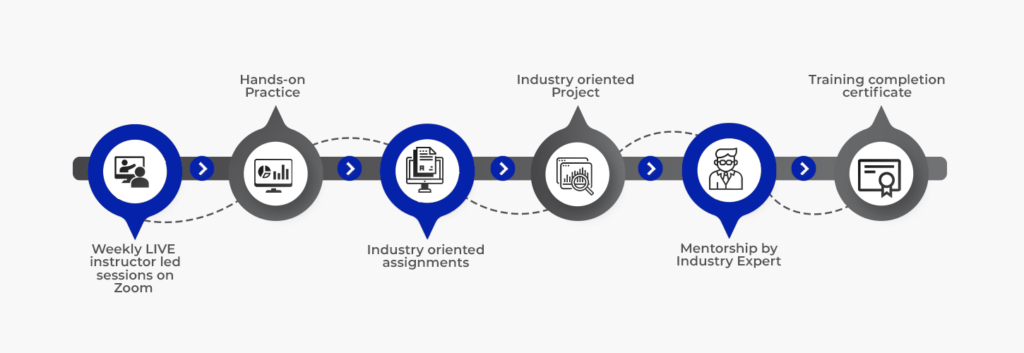
Overview
- Event-driven scaling
- Disaster recovery and failover strategies
- Monitoring and Compliance Testing of AWS services
- Best Practices to be followed while working with amazon web services
- Making scalable, reliable, and highly available infrastructures with AWS
- Making decisions based on the AWS recommended architectural principles & practices
Tools Covered





- Business/Marketing Heads & Executives
- C-Suite Employees responsible for determining and achieving Revenue Targets
- Sales Heads & Executives
- IT employees assigned for assisting Sales, Marketing and Business Analytics Departments
- Students/graduates with business, commerce, marketing background
- Exam 77-420:Microsft Excel 2013
- SQL Relational Databases 101
Course Outline
- Week 1
- Week 2
- Introduction
- AWS Certification
- What does the exam cover
- Create a billing alarm
- Identity Access Management (IAM)
- AWS Regions and Availability Zones (AZ)
- IAM introduction
- IAM roles and policies
- Quiz
- Elastic Cloud Compute (EC2)
- Introduction
- EC2 Instance Connect
- Security Group introduction
- Security Groups deep dive
- Instance launch types
- Spot instances and spot fleet
- Instance Types Deep Dive
- Amazon Machine Images (AMIs)
- Cross account AMI copy
- Private vs Public vs Elastic IP
- Install Apache on EC2
- EC2 user data
- EC2 Instance Metadata
- CLI Setup Linux or Window
- CLI on EC2
- CLI Practice with S3
- Quiz
- EC2 Storage
- EC2 Placement Groups
- High availability and scalability
- Introduction
- Elastic Load Balancing (ELB)
- Types of Load Balancers
- ELB stickiness
- ELB cross zone load balancing
- ELB SSL Certificates
- ELB connection draining
- Auto Scaling Groups (ASGs)
- ASG scaling policies
- Week 3
- Week 4
- Route53
- Time To Live (TTL)
- Introduction
- Route53 and EC2 Setup
- Time To Live (TTL)
- CNAME vs Alias
- Health checks
- Routing policies
- 3rd party domains
- Quiz
- Virtual Private Cloud (VPC)
- Introduction
- CIDR, private vs public IP
- Default VPC
- Subnet
- Internet Gateway and Route Tables
- NAT Instances
- NAT Gateway
- DNS Resolution Options and Route 53 private zones
- NACL and security groups
- VPC peering
- VPC Endpoints
- Site to site VPN, Virtual Private Gateway and Customer Gateway
- Direct Connect & Direct Connect Gateway
- Egress only Internet gateway
- Networking costs in AWS
- Simple Storage Service (S3)
- Versioning
- Websites hosted on S3
- MFA delete
- Replication (cross region and same region)
- Quiz
- CloudWatch
- Introduction
- Encryption
- Cross Origin Resource Sharing (CORS)
- Default encryption
- Lifecycle policies
- Monitoring and Audit
- CloudTrail
- Buckets and objects
- Security and bucket policies
- Consistency model
- Access logs
- Week 5
- Week 6
- Decoupling applications
- Introduction
- Simple Queue Service (SQS)
- SQS FIFO queues
- SQS and auto scaling group
- Simple Notification Service (SNS)
- Kinesis Data Streams
- Kinesis Firehose and Data Analytics
- Data ordering for Kinesis vs SQS FIFO
- SQS vs SNS vs Kinesis
- Message Queue (MQ)
- Quiz
- Serverless
- Introduction
- Lambda
- Lambda limits
- Lambda@Edge
- DynamoDB
- DynamoDB advance features
- Databases on AWS
- Relational Database Service (RDS) overview
- RDS replicas vs multi AZ
- RDS encryption and security
- Aurora
- Elastic Cache
- DynamoDB
- S3 as database
- Athena
- Choosing the right database
- Quiz
- Disaster recovery and migrations overview
- Introduction
- Database Migration Service (DMS)
- On-premise strategies with AWS
- DataSync
- Transferring large datasets into AWS
- Quiz
- Week 7
- Week 8
- CloudFront and Global Accelerator
- Signed URLs and cookies
- Global Accelerator overview
- Quiz
- Other storage services
- Snowball and Snowmobile
- Storage Gateway
- FSx overview
- AWS storage options compared
- Quiz
- Security and encryption
- Introduction
- Encryption 101Key Management Service (KMS)
- Secrets Manager
- Cloud Hardware Security Module (HSM)
- Shared Responsibility Model
- Quiz
- Other topics and solution architectures (Basic Overview)
- Event Processing in AWS
- Caching Strategies in AWS
- Blocking an IP Address in AWS
- High Performance Computing (HPC) on AWS
- EC2 Instance High Availability
- Exam preparation discussions
- Beanstalk Overview
- Developing on AWS Introduction
Our Methodology
Industry Usecases
With real world projects and immersive content built in partnership with top tier companies, you’ll master the tech skills companies want.
Technical Support
Our knowledgeable mentors guide your learning and are focused on answering your questions, motivating you and keeping you on track.
Career Mentorship
You’ll have access to resume support, portfolio review and optimization to help you advance your career and land a high-paying role.

Frequently Asked Questions
Yes, You will be awarded a course completion certificate by Dice Analytics if you pass the course.
Since our trainings are led by Industry Experts so it is made sure that content covered in workshop is designed with hand on knowledge of more than 70-75 % along with supporting theory.
For this professional workshop, you need to have a PC with minimum 4GB RAM and ideally 8GB RAM.
Don’t worry! We have got you covered. You shall be shared recorded lectures after each session, in case you want to revise your concepts or miss the lecture due to some personal or professional commitments.
Yes, you can rejoin the training within the span of an year of your registration. Please note following conditions in case you’re rejoining.
1) There are only 5 seats specified for rejoiners in each iteration.
2) These seats will be served on first come first basis.
3) If you have not submitted your complete fee, you may not be able to rejoin. Your registration would be canceled


